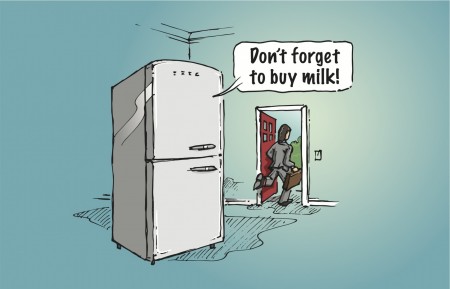February 8, 2016 – Peter Diamandis talks about what happens when eight different exponential technologies come onto the scene at the same time. In a series of blogs that I will share with my readers here he waxes poetic on a future where the following fields will morph and recombine to produce an unpredictable future. What’s fields are these?
- Computation
- Internet of Things
- Robotics/Drones
- Artificial Intelligence
- 3D Printing
- Materials Science
- Virtual/Augmented Reality
- Synthetic Biology
In this mind sharing, Diamandis talks about the Internet of Things, the networks and sensors that are altering our reality. Diamandis invited Raj Talluri, Senior VP of Product Management at Qualcomm to give us a sense of the present and near future in this field. Here is what he has written.
———-
The Earth is being covered by an ever-expanding mesh of networks and sensors that form the Internet of Things (IoT). Think of the IoT as the network of all digitally accessible objects, estimated at 15 billion in number today, and expected to grow to more than 50 billion by 2020. Each of these connected devices, is in itself made up of a dozen sensors measuring everything from vibration, position and light, to blood chemistry and heart rate. Now imagine a world rapidly approaching a trillion sensor economy where the IoT enables a data-driven future in which you can know anything you want, anytime you want, anywhere you want. A world of instant, high-bandwidth, communications and near perfect information. The implications of this are staggering.
Recent Top 5 IoT Breakthroughs (2012 to 2015)
1. Emergence of Continuous Low-Power Always-On Sensors
One of the major advances from the past three years has been the proliferation of always on sensors. States Talluri, “You’ll be amazed how many of your phone sensors are always on. If you look at your phone, there were times when you had to press the button to say ‘Okay Google’ or ‘hi Siri.’ Now, you don’t. You just talk to it and it figures it out.”
He continues, “This has been made possible because you’re now able to make very low power sensors that listen to you all the time, keyword detect and do the data processing.”
2. Smartphones Drives Sensor Volume at Low Cost
The number of sensors in your smartphone today have exploded. Talluri states, “We are now seeing 10, 20 and even 30 sensors embedded in our smartphones. Things like proximity sensors when you pick your phone up, gyros, cameras, depth sensors and so on. This has really driven down cost and driven the discovery of new sensors, because there are a billion smartphones [sold] every year. It’s a huge opportunity.” A billion phones means 20 billion+ sensors – and we are headed towards a trillion sensor economy.
3. “Systems” Fuse Continuous Sensor Data & Cloud Processing
Seamless integration of processing is happening in the cloud and on your device. Talluri explains, “When you say, ‘Okay, Google,’ a part of what happens next is on the phone and a part is in the cloud. You don’t really know where the processing is being done, on your device or in the cloud…the hand off is seamless.”
4. 4K Video Format Goes Mainstream
4K screen resolution is close to the point that the brain is unable to notice pixels. As such, somewhere between 4K and 8K, virtual reality becomes visually equal to visual reality. Talluri explains how this technology is exploding. “If you buy a 4K TV and watch 4K content, it’s very hard to go back to 1080p. It almost feels like you were watching a VHS tape when DVDs came out. Today, if you look at what we’ve done at Qualcomm in the high-end processors space, we shipped over 200 to 250 million processors that actually record in 4K.”
5. Opening of Sensor APIs to 3rd Party Apps Development Community
The reality is that the majority of phone apps now come from third party developers. This explosion in apps (perhaps 50 to 100 per phone) is only possible because of (i) the opening of the APIs for the sensors in the devices and (ii) the community of developers that has emerged as a result.
So what’s in store for the near future?
Anticipated Top 5 Breakthroughs (2016 to 2018)
Talluri predicts the following:
1. Wireless Network Densification (4G/5G): Cost per Megabit Plummets
The cost per megabit of connection is going to plummet – essentially nearing “free” in the very near future. Talluri states, “Already in places like Indonesia, we find that people are actually getting data plans at a price of $5 a month. In most of the world, the cost per megabit is extremely low as the cost of launching networks is plummeting.”
2. Emergent Peer-To-Peer Tech Drives Automotive Communication & Safety
Soon all of your devices at home and work (screens, thermostats, DVRs, computers, even cars) will automatically connect seamlessly. You won’t have to make conscious decisions about how to connect your washing machine. When it finishes washing the clothes, you will get a notification on your phone.
3. Global Internet Connectivity via Satellite Plummets in Cost
Qualcomm, in partnership with Richard Branson, is working to deploy a 648 satellite constellation called OneWeb. Talluri explains, “Global Internet connectivity through satellites is finally going to happen… Just think about three billion new people coming online at a megabit per second. It is going to be completely different kind of experience.”
4. Exponential Growth in Connections to Internet from Various Devices – Personal/Home/Cities
Talluri remarks, “I often ask people: how many IP addresses do you think you have at your house?” Most people have no clue. They say maybe two or three. But it’s more like 50, your TVs, set top boxes, phones, tablets, Nest thermostat, digital cameras, even smart light bulbs. Talluri continues, “In the next few years, the number of things that will be connected to the Internet at any given point of time in your life is going to be so huge that the way they work is going to be very different. You won’t need to reach for your phone to do something. Coupled with sensor networks, you’ll just be able to speak and ask for what you want.”
5. Major Improvements of Head-Mounted User Interfaces with Rich Bandwidth and On Board Sensors
Over the next three years, we’ll see rapid uptake of virtual and augmented reality headsets, each with 4K displays and cameras, and packed with a suite of sensors connected by high bandwidth communications to the cloud. The result is that each of us is wearing an incredible user interface with high-speed communications that will make virtual experiences so good you won’t need to travel to experience something.
———-
I look forward to sharing more of these speculations on converging trends in future postings, and as always welcome comments and ideas that you, my readers, may want to share about the future as you envision it. Thanks for continuing to drop in here at 21st Century Tech.
Since I began these postings more than a million worldwide have visited the site. Many of my postings have been translated and appear on numerous other sites. If someone asked you thirty years ago to imagine a world where one person writing in their home could be connected to hundreds, thousands and even millions of people, would you have believed it possible? That’s today’s reality. It’s no longer imagination.
















